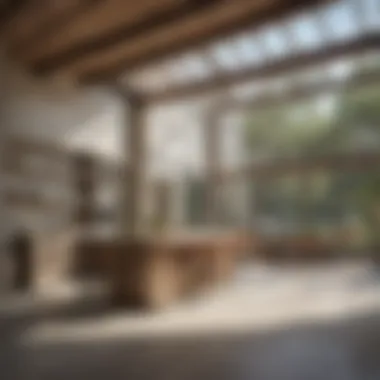Why Basements Are Rare in Florida Homes


Intro
In Florida, the absence of basements is a striking characteristic of home design. Understanding why this is the case requires a look at several interconnected factors. While basements are common in many parts of the United States, Florida presents unique geological and climatic challenges that make them less feasible. This article dissects these challenges and explores how they shape residential construction.
Many Florida residents might not think twice about their lack of a basement. However, understanding this absence reveals important insights about the state's architectural trends, flood risks, and homeowner needs. This examination is relevant not just for residents but also for prospective home buyers, builders, and architects.
Key Points to Discuss
- Geological Factors: Florida's geology plays a significant role in basement construction. The state sits atop a limestone bedrock, which influences groundwater levels.
- Climate Considerations: Florida's warm climate, combined with its history of flooding, leads to different priorities in home design.
- Construction Trends: Traditional construction methods and local building codes also dictate the prevalence of basements in Florida homes.
- Practical Implications: The absence of basements affects storage options, insurance implications, and even community design.
This comprehensive guide aims to provide clarity on these points while illustrating why basements remain an uncommon feature in the Sunshine State.
Geological Considerations
The absence of basements in Florida is largely rooted in geological factors that characterize the region. An understanding of these geological considerations is essential in comprehending the broader context of residential design in Florida. Key elements include soil composition, water table levels, and natural drainage patterns. Each of these aspects plays a significant role in influencing the construction practices and necessitates careful consideration for homeowners and builders alike.
Soil Composition
Florida's soil primarily consists of sandy and loose materials, which are not ideal for supporting a basement structure. The sandy texture causes poor stability and increases the risk of shifting, leading to complications in building foundations. Builders often prefer solid ground that can safely support multi-level homes. The presence of clay in some areas makes it more complicated, as it retains water, causing soil expansion and contraction. This variability in soil composition necessitates a careful assessment to ensure that homes built on this foundation are safe and sustainable, thus discouraging basement construction.
Water Table Levels
The water table in Florida is notably high compared to many other states. With much of the land sitting at or near sea level, there is a constant risk of inundation, especially during heavy rains. The elevation of the water table presents a significant challenge for basement construction. Basement spaces below the water table are prone to flooding, resulting in structural damage and considerable financial loss. Consequently, it is more prudent for builders to avoid basements altogether in light of these water table conditions, redirecting designs towards safer, above-ground living spaces.
Natural Drainage Patterns
Florida's natural drainage patterns also contribute to the scarcity of basements. The state's flat topography results in slow water drainage, leading to puddling and water accumulation. In areas prone to flooding, any underground space is at a higher risk of being filled with water, which can create significant difficulties for homeowners. This possibility of water accumulation leads builders to design homes that elevate living spaces above typical flood levels, further reducing the feasibility of basements.
"Flood-prone areas require elevated designs to mitigate water accumulation risk, pushing builders away from basements entirely."
Given these geological considerations, it is clear why basements are rare in Florida. Understanding these factors helps homeowners make informed choices about their residences and influences future construction practices.
Climatic Factors
Humidity and Moisture Levels
Florida is known for its high humidity. This state has a subtropical climate, characterized by warm temperatures and significant moisture in the air. The humidity can reach over 90% at times, creating a damp environment. This pervasive moisture poses a serious challenge for basements. If built, basements would likely face constant issues with mold and mildew. Homeowners tend to avoid these problems by opting for homes without basements. Moreover, the construction materials used in Florida are typically chosen for their ability to withstand not only the humidity but also the heat. This further discourages underground spaces, where moisture retention would be a constant concern.
Hurricane Risks
Florida is vulnerable to hurricanes. The state experiences several hurricanes each year, with some causing substantial damage. In terms of structural considerations, basements are less ideal. Flooding is the most pressing concern during hurricane season. High winds and heavy rain can lead to rising water levels, which increases the likelihood of flooding in low-lying areas, including basements. Given that many parts of Florida are often in flood zones, building without a basement is a practical decision. It enhances safety and minimizes property damage during extreme weather events.
Seasonal Rainfall Patterns
Florida experiences distinct seasonal rainfall patterns, with summer months often bringing heavy downpours. The intensity and frequency of rain can lead to surface runoff in areas with poor drainage. This compounded with high water tables creates a challenging environment for homes with basements. Even during regular rainy seasons, the risk of groundwater rising near structures presents a significant issue. Instead of downwards toward a basement, builders focus on elevating homes to keep them above potential flood levels.


The unique combination of humidity, hurricane threats, and seasonal rainfall patterns makes basements impractical in Florida.
Overall, the climatic factors in Florida create a natural aversion to basement constructions. Considering the impacts on home safety and maintenance, it's clear why homeowners in the Sunshine State prefer alternative structural designs.
Construction Practices
Understanding construction practices in Florida is crucial to grasp why basements are rarely found in homes across the state. Several factors, including foundation types, costs involved in construction, and adherence to local building codes, significantly influence the absence of these subterranean spaces.
Foundation Types Used
In Florida, the most common foundation types include slab-on-grade and elevated foundations. The slab-on-grade method places a concrete slab directly on the ground. This design is advantageous in a state with high water tables and periodic flooding, as it requires minimal excavation and is less prone to water-related damage. Elevated foundations, meanwhile, are often preferred in flood-prone areas, raising the living space above potential floodwaters.
These foundation types are not conducive to basement construction. The local soil composition and moisture levels necessitate a building design that avoids creating below-ground spaces, which can lead to water intrusion issues. Furthermore, both foundation types are efficient for the warm climate of Florida, reducing energy costs and providing comfortable living environments.
Cost Implications
Constructing a home without a basement can lead to various cost benefits. The expenses related to excavation and waterproofing basements can be significant. Instead, Florida builders focus on designing homes with their unique characteristics in mind, like using slab foundations, which can be less expensive to implement.
Also, the lack of basements simplifies the building process. This results in shorter construction times, thus reducing labor costs. In addition, Florida real estate markets often offer properties without basements at a lower price point, which is more appealing to many homebuyers.
It's critical to consider ongoing costs as well. Without a basement, homeowners avoid potential future expenses related to basement maintenance, such as water damage repairs and mold remediation.
Local Building Codes and Regulations
Local building codes in Florida play a significant role in shaping home designs. These codes are enacted to ensure safety and resilience against natural disasters, particularly hurricanes and flooding. As a result, building practices tend to emphasize structures that can withstand these environmental factors, rather than traditional types that may include basements.
For instance, the Florida Building Code mandates that new homes must be elevated in flood-prone regions. As most of the state falls within flood zones, the codes necessitate homes to be built above a certain Base Flood Elevation. This requirement further discourages the incorporation of basements, which would be submerged in many cases.
The structural choices made in Florida reveal a pragmatic approach shaped by geological and climatic realities, making basements less viable.
Practical Implications of No Basements
The absence of basements in Florida holds significant practical implications for homeowners. This section explores the specific considerations and benefits that arise from living in homes without basements. Attention to this topic is essential for understanding how residents adapt to their unique environment, balancing their needs with the constraints imposed by geological and climatic factors. With this understanding, one can appreciate the alternative solutions and adjustments that have become commonplace in Florida's residential designs.
Storage Solutions
Without basements, homeowners must be creative about storage. This leads to innovative solutions for managing belongings. Some options include:
- Attics: Many Floridians utilize attics for storage. While not as spacious as basements, attics can hold seasonal items, holiday decorations, or even old furniture.
- Custom cabinetry: Built-in shelves and cabinets in living areas often serve as storage spaces. This helps to maximize the use of vertical space.
- Outdoor storage sheds: Many homes feature sheds or small storage units in yards. This approach keeps garages less cluttered and offers a convenient spot for gardening tools or recreational equipment.
In the context of urban living, these solutions may also reduce clutter within the home, fostering a more organized space. Listings show that homes with smart storage solutions remain attractive to buyers.
Alternative Spaces for Utilities
The absence of a basement leads to changes in where homeowners place utilities. These include plumbing, electrical, and HVAC systems. Typically, the following spaces are considered for utilities:


- Crawl spaces: Though less common, some homes may have crawl spaces. This option can provide access to plumbing and electrical systems, although it's generally more limited in space.
- Interior closets: Some builders place water heaters and HVAC systems in closets rather than basements. This keeps the systems protected and makes maintenance easier.
- Utility rooms: A designated utility room is another popular choice. These rooms might house laundry facilities alongside other essential utilities.
While these alternative placements can effectively operate within Florida homes, they also require special attention to accessibility and design to ensure that they do not interfere with normal home activities.
Impact on Home Layouts
The absence of basements affects the overall design and functionality of Florida homes. Home layouts tend to be more open and spread out, with several key factors influencing this:
- Single-story designs: As basements are not standard, many Florida homes favor a single-story layout. This design approach simplifies movement throughout the house and can be more suitable for families with young children or seniors.
- Maximized outdoor living: Often, homeowners emphasize outdoor spaces. Patios and porches can serve as extensions of the indoor living areas, enhancing the quality of life and the connection to the environment.
- Flexible floor plans: Many homeowners might opt for flexible designs that can adjust to varying needs. Spaces once meant for basements can now transform into additional living or recreational areas.
Cultural and Historical Context
The cultural and historical context surrounding housing in Florida reveals essential insights into why basements are significantly absent. Florida's unique history, influenced by multiple factors, has shaped residential designs over time. Understanding this context is crucial as it unravels the complexities of housing trends that persist today.
Historical Housing Trends in Florida
Historically, Florida's housing development has been driven by its climate and geographical location. The warm weather and tropical nature of the region encouraged the construction of houses designed for outdoor living. From the early 20th century, the emphasis was placed on light, airy homes that could withstand the elements, notably hurricanes.
Characteristics of homes built during this time include single-story structures, wood-frame designs, and expansive porches. These architectural choices reflect a preference for maximizing ventilation and protection from heat rather than creating additional, below-ground spaces like basements. The influence of Spanish and Caribbean architecture also can be seen; these styles prioritize open spaces and natural climate resilience.
Moreover, as Florida became a central meeting point for various cultures and influxes of tourism, the housing market began to adapt. The shift towards seasonal homes and vacation properties further decreased the need for basements, as many homes were designed simply for temporary stays, requiring less functional storage.
Influence of Migration Patterns
Migration patterns to Florida play a critical role in the understanding of housing trends. People moving to Florida often looked for homes that aligned with their lifestyles. Many were retirees or families seeking warmer climates, which resulted in residential preferences that avoided features like basements.
As a result, homes have become predominantly one or two stories, focusing on ease of accessibility for older populations.
The influx from northern states, where homes often feature basements for storage and utility, did not translate into Florida's market. New arrivals instead gravitated toward open layouts and outdoor amenities. A growing awareness of tropical storm risks also impacted design decisions—homeowners prioritize storm readiness over traditional elements like below-ground storage.
In summary, the interaction of Florida’s geological factors, historical architectural styles, and migration patterns has led to a distinctive housing landscape. The absence of basements is not merely a choice, but deeply embedded in the state’s cultural and historical evolution.
Flood Considerations
Flood Zone Regulations
Flood Zones represent key areas designated by the Federal Emergency Management Agency (FEMA) based on their flood risk. In Florida, many properties fall within these zones due to the state's low-lying topography. As homeowners consider property purchases or build new houses, understanding these regulations is essential. Local governments often impose strict building codes for homes located in flood-prone areas.
Generally, homes in higher flood risk areas must adhere to standards that elevate living spaces above the potential flood levels. This leads to the construction of homes on pilings or elevated foundations, pushing living spaces to a higher level and eliminating the need for basements. In addition, available resources such as FEMA provide guidelines that homeowners must follow, ensuring structures can withstand flooding events.
Insurance Implications for Homes Without Basements
The absence of basements in Florida homes has significant implications for flood insurance. Many families are provided protection through the National Flood Insurance Program (NFIP), which requires specific coverage levels based on the property’s flood zone. Homes without basements may inherently bear a lower risk profile since they do not have typical basement vulnerabilities. However, this does not absolve them from flooding risks entirely.
Homeowners should understand that flood insurance premium rates can vary significantly with the property’s elevation relative to flood levels. Though elevated homes may cost less to insure due to lower flood risks, homeowners can still face challenges, such as keeping up with the changing regulations from FEMA. Insurance considerations, therefore, are a vital part of the housing landscape in Florida, influencing homeowners' decisions regarding flood preparedness and risk management.


"Living without a basement can be less problematic in flood zone yet homeowners must proactively protect their properties against water damage."
Future Trends in Florida Housing
The topic of future trends in Florida housing is essential to understanding how residential design will evolve in response to various challenges. The absence of basements has implications that extend into how homes are structured, the kind of materials that are used, and how sustainability practices can be integrated. By exploring these trends, we can gain insights into the adaptive measures Florida will take to address both environmental factors and consumer preferences.
Emerging Architectural Designs
As architects and builders in Florida continue to innovate, emerging architectural designs are focusing on elevating homes above typical flood levels. This approach not only provides peace of mind for homeowners but also enhances livability in flood-prone areas. Elevated homes often incorporate open floor plans and large windows to maximize natural light and ventilation, a response to the region's warm climate.
Additionally, more builders are considering modular and prefabricated construction methods. These designs reduce build times and costs while allowing for customizability. Utilizing materials that are resistant to moisture and pests has become a priority. For instance, concrete and treated wood are favored for their durability and lower maintenance requirements.
Pros and Cons of Emerging Designs
- Pros:
- Cons:
- Increased resilience to flooding
- Enhanced energy efficiency and sustainability
- Flexibility in design choices
- Higher initial investment for some designs
- Potential zoning issues with elevated structures
Innovations in Flood-Resistant Building
Innovations in flood-resistant building are transforming how homes are constructed in Florida. Builders are now incorporating flood-resistant measures that go beyond traditional designs. Features like flood vents, elevated utilities, and reinforced foundations are increasingly standard. These modifications serve to minimize water damage risks without compromising on aesthetic value.
One prominent method involves the use of floating foundations. These structures, while still in developmental stages, can rise with floodwaters, thus reducing damage when flooding occurs. Building codes are also adapting to these innovations, requiring that homes in flood zones adhere to stricter resilience standards.
"The innovative shift to flood-resistant building signifies a growing awareness of climate impacts on housing."
Key Elements of Flood-Resistant Innovations
- Elevated Construction: Keeping the living area above likely flood levels
- Water-Resistant Materials: Using treated wood and water-resistant composites
- Drainage Solutions: Implementing advanced drainage systems to manage excessive water
The End
In analyzing the absence of basements in Florida, it is crucial to synthesize the various elements contributing to this unique architectural trait. The examination covers geological, climatic, and practical factors that collectively deter the presence of basements in homes across the state.
The geological makeup, marked by sandy soils and high water table levels, plays a fundamental role. These natural conditions pose challenges for construction, particularly regarding drainage and stability, which are vital for basements. Moreover, Florida's subtropical climate subjects homes to high humidity and seasonal rains, exacerbating the risk of flooding, thus making below-ground structures less practical.
From a construction standpoint, Florida builders often favor alternatives that align with local regulations and cost-effective practices. This preference leads to the predominance of elevated structures, which can mitigate flooding risks.
Additionally, the practical implications of living without basements are significant. Readers gain insight into how storage and utility arrangements are adapted within Florida homes, showing that effective solutions have a notable impact on resident lifestyles.
Understanding these factors ultimately provides a comprehensive viewpoint on Florida's housing norms. It not only emphasizes why basements are uncommon but also highlights the adaptability of homeowners in response to their unique environment.
"The absence of basements is not merely a preference but a necessary adaptation to Florida's natural and climatic conditions."
Summary of Key Points
- Geological factors, such as sandy soil and high water tables, contribute to the impracticality of basements.
- Florida's humid climate and hurricane risks make below-ground living spaces less desirable.
- Local construction practices favor homes on slabs or pilings instead of basements.
- The practical effects of no basements lead to creative storage solutions and alterations in home layouts.
Final Reflections on Housing Norms in Florida
Housing norms in Florida reflect a unique blend of environmental challenges and innovative solutions. The decisions surrounding the absence of basements showcase the resilience and adaptability of builders and homeowners alike. As climate change continues to influence weather patterns, it will be interesting to observe how construction practices evolve in response to ongoing environmental concerns. The landscape of Florida homes may continue to shift, yet the current understanding of why basements are largely absent offers a substantial foundation for future exploration in residential architecture.







